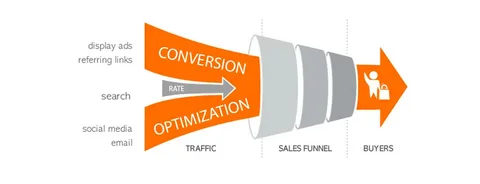In the fast-paced business environment of New York City, simply attracting website visitors isn’t enough—you need to convert them into paying customers. This is where data-driven Conversion Rate Optimization (CRO) comes into play. By leveraging analytics, A/B testing, and user behavior tracking, NYC businesses can refine their digital presence to maximize engagement, increase conversions, and outperform competitors.
This guide explores the best data-driven CRO strategies for businesses in NYC and how Robust Connections can help you implement them effectively.
Why CRO is Important for NYC Businesses
NYC is one of the most competitive markets in the world, with businesses in e-commerce, real estate, law, healthcare, and home services vying for consumer attention. While attracting website traffic through SEO and paid ads is crucial, it is CRO that determines how many of those visitors actually convert into leads, customers, or clients.
Without conversion optimization, businesses waste marketing budgets on traffic that doesn’t result in revenue. A well-optimized site ensures that every visitor has a seamless, engaging, and persuasive experience that encourages action—whether that’s booking a consultation, making a purchase, or signing up for a service.
The Impact of CRO on NYC Businesses
CRO impacts every aspect of a business’s digital marketing success and profitability. The major effects include:
- Higher ROI on Marketing Spend: Instead of continuously increasing ad budgets to attract more traffic, businesses maximize revenue from existing visitors.
- Improved User Experience: A well-optimized website provides faster load times, easy navigation, and engaging content, leading to lower bounce rates and higher conversions.
- Better Customer Retention: A seamless experience increases trust and encourages repeat business.
- Stronger Competitive Edge: NYC consumers have countless options—CRO ensures that your business stands out and convinces visitors to choose you over competitors.
- More Qualified Leads: Data-driven CRO ensures that your site attracts and converts the right audience, reducing unqualified leads and wasted time.
Key Benefits of CRO for NYC Businesses
1. Increased Revenue without Additional Ad Spend
Instead of spending more on PPC or SEO to attract visitors, CRO helps businesses extract more value from existing traffic, significantly increasing revenue.
2. Enhanced Local SEO Rankings
Google rewards websites with low bounce rates, longer session durations, and high engagement—all of which CRO improves. A well-optimized site enhances NYC local search visibility, helping businesses rank higher on Google.
3. Higher Mobile Conversions
With most NYC consumers browsing on mobile, CRO ensures a mobile-friendly experience, leading to higher conversions from smartphone users.
4. Competitive Advantage in NYC’s Crowded Market
A well-optimized website helps NYC businesses outperform competitors by delivering a superior user experience that persuades visitors to convert.
5. Better Lead Nurturing & Sales Funnel Optimization
CRO ensures that leads move smoothly through the sales funnel by removing friction points, improving call-to-action clarity, and providing a seamless user journey.
Advanced CRO Strategies for NYC Businesses
A/B Testing & Multivariate Testing
One of the most effective CRO techniques, A/B testing involves comparing two versions of a webpage, ad, or email to see which performs better. NYC businesses can test elements such as headlines, CTA buttons, page layouts, and images to optimize performance. Multivariate testing, which tests multiple variables simultaneously, helps refine elements even further.
For instance, an NYC e-commerce store might run an A/B test on different product page designs to determine which layout leads to the highest sales.
Behavioral Analytics: Understanding NYC Consumer Actions
Behavioral analytics involves tracking and analyzing user behavior on a website to determine patterns and trends. NYC businesses can use tools like Google Analytics, Hotjar, and Mixpanel to study metrics such as time on site, bounce rates, click-through rates, and navigation paths. These insights help businesses understand how customers interact with different pages and where they may be encountering issues.
For example, if users frequently abandon a checkout page, businesses can analyze the data to determine whether the issue is a confusing interface, slow load time, or a lack of trust signals like security badges. By addressing these factors, businesses can reduce friction and increase conversions.
Funnel Analysis: Identifying Drop-Off Points in NYC Sales Pipelines
A funnel analysis allows businesses to visualize the customer journey from initial visit to conversion. By identifying drop-off points in the funnel, businesses can make data-driven improvements. For NYC businesses, this means tracking customer behavior at each stage—awareness, consideration, and decision-making—to optimize every touchpoint.
For example, a NYC law firm may notice that visitors frequently visit their contact page but fail to submit a form. A funnel analysis can reveal whether the form is too long, lacks mobile optimization, or is missing a compelling CTA. Adjusting these elements can significantly improve lead conversions.
Multi-Touch Attribution: Tracking the NYC Customer Journey
Multi-touch attribution tracks all the touchpoints a customer interacts with before converting. This is crucial in New York’s competitive digital market, where customers engage with brands across multiple platforms before making a decision.
Using tools like Google Attribution or HubSpot, businesses can determine whether SEO, paid ads, email marketing, or social media contribute most to conversions. This helps businesses allocate their marketing budget more effectively, ensuring maximum ROI.
Conversion Rate Benchmarks: Where Does Your NYC Business Stand?
Conversion rate benchmarks vary by industry, and NYC businesses must compare their performance against competitors. For example:
- E-commerce: A good conversion rate is 2-3%, but top-performing brands in NYC achieve 5% or more.
- Real estate: A well-optimized landing page should have a conversion rate of 10% or higher for lead forms.
- Legal services: Law firms should aim for a conversion rate of 5-8% for consultation bookings.
By knowing where they stand, businesses can develop tailored strategies to improve conversions.
Personalization & Dynamic Content: Boosting Engagement in NYC Markets
NYC consumers expect personalized experiences. By leveraging AI-driven personalization and dynamic content, businesses can enhance engagement and increase conversions.
For instance, an NYC fashion retailer can use AI to recommend products based on a visitor’s browsing history. Similarly, a real estate firm can display property listings based on a user’s location and preferences. These personalized experiences significantly boost customer retention and conversion rates.
Predictive Analytics in CRO: Forecasting User Behavior for NYC Businesses
Predictive analytics uses historical data to forecast future customer behavior. By analyzing factors such as past purchases, browsing habits, and demographic data, businesses can predict which visitors are most likely to convert.
For example, an NYC home services company can use predictive analytics to determine when homeowners are most likely to schedule maintenance services, allowing them to optimize ad targeting and promotional timing.
Session Replays & User Journey Mapping: Eliminating Conversion Barriers
Session replay tools like FullStory and Crazy Egg allow businesses to watch real-time recordings of user interactions. This helps identify pain points, slow-loading pages, and navigation issues that may be hindering conversions.
User journey mapping, on the other hand, helps businesses visualize the entire path users take before converting. This is particularly useful for NYC hospitality and tourism websites, where booking processes need to be seamless.
Landing Page Heatmaps: Optimizing Key Conversion Areas
Heatmaps provide visual representations of user interactions, showing where users click, scroll, and hesitate. NYC businesses can use this data to improve CTA placements, simplify navigation, and restructure landing pages for better conversion rates.
Micro-Conversions vs. Macro-Conversions: Measuring Success in NYC
While macro-conversions (purchases, sign-ups) are crucial, micro-conversions (engagement actions like clicking on a CTA or signing up for a newsletter) play an essential role in the conversion funnel. NYC businesses should track both types of conversions to refine their CRO strategies and guide users toward completing high-value actions.
AI-Powered CRO: Leveraging Machine Learning for Better Conversions
Artificial intelligence is transforming CRO by automating A/B testing, analyzing customer data, and personalizing experiences. AI-powered chatbots, recommendation engines, and predictive models are revolutionizing how NYC businesses engage with customers and increase conversions.
Cross-Device Tracking: Optimizing NYC User Experience Across Platforms
New York consumers often switch between multiple devices before making a purchase. Implementing cross-device tracking ensures a seamless experience across desktops, smartphones, and tablets, improving the chances of conversion regardless of how customers access your website.
Cognitive Bias & Persuasion Psychology: Applying Behavioral Science to CRO
Understanding cognitive biases like social proof, scarcity, and authority can help businesses craft persuasive marketing messages. Implementing these psychological triggers in website design, CTAs, and content can significantly increase conversions.
Real-Time Data Optimization: Making Instant Changes for Better Results
Real-time data tools allow NYC businesses to adjust their CRO strategies on the fly. Whether it’s modifying a CTA, updating pricing based on demand, or optimizing ad placements, having the ability to make immediate changes can be a game-changer in competitive markets.
Page Speed Optimization: How Site Performance Impacts CRO & SEO
Discuss the correlation between site speed, bounce rate, and conversions and provide actionable speed optimization techniques
Omnichannel CRO: Aligning Online & Offline Customer Journeys in NYC
Explain how businesses with physical locations (restaurants, boutiques, service providers) can bridge the gap between digital and in-store experiences for better CRO.
Localized Content & Geo-Targeted CRO for NYC Businesses
Explain how geo-targeting, local landing pages, and hyper-personalized messaging increase conversions for businesses operating in different NYC boroughs
How Robust Connections Helps NYC Businesses Increase Conversions & ROI
At Robust Connections, we specialize in data-driven CRO strategies designed to help NYC businesses improve their conversion rates and maximize revenue. Our team of experts uses cutting-edge analytics tools, A/B testing, and UX optimization to fine-tune websites for peak performance.
Our services include:
- Comprehensive CRO audits to identify areas for improvement
- A/B testing and user experience optimization to boost engagement
- Advanced tracking and analytics to refine marketing strategies
- Local SEO integration to increase visibility in NYC search results
- Landing page optimization and CTA enhancement to drive conversions
Businesses that work with Robust Connections gain a competitive edge in the NYC market by turning more website visitors into loyal customers.
Final Thoughts
For businesses in New York City, conversion rate optimization isn’t optional—it’s essential for growth. By leveraging data-driven CRO strategies, companies can enhance user experience, increase conversions, and outperform competitors.
If you’re looking to turn website visitors into paying customers, Robust Connections is here to help. Our expert team specializes in creating customized CRO solutions that drive real results for NYC businesses.
Ready to boost your conversion rates and maximize ROI? Contact Robust Connections today for a free CRO consultation!


